
Green Gemstones: List of 31 Green Gems and Their Meanings
 If you’re in the market for colored gemstones, green crystals are an excellent choice! Green gemstones are a delight to look at, wear, and use for healing. From bright lime to muted pistachio, to deep forest green, green stones and crystals come with dozens of opportunities.
If you’re in the market for colored gemstones, green crystals are an excellent choice! Green gemstones are a delight to look at, wear, and use for healing. From bright lime to muted pistachio, to deep forest green, green stones and crystals come with dozens of opportunities.
What stones are green in color? Today, we’ll cover a comprehensive list of green crystal names and meanings:
Green Gemstones
Emerald
Jade
Maw Sit Sit
Alexandrite
Malachite
Apatite
Chrysoprase
Garnet
Sapphire
Amazonite
Chrysoberyl
Prasiolite
Peridot
Turquoise
Chrysocolla
Chrome Diopside
Diaspore
Moldavite
Prehnite
Hiddenite
Agate
Green Tourmaline
Green Topaz
Green Fluorite
Green Jasper
Green Opal
Green Calcite
Green Moonstone
Green Spinel
Green Aventurine
Green Diamond
Before we dive into each gemstone, let’s talk about the spiritual side. What does the green crystal stand for?

Green Gemstones Meaning
The color green symbolizes growth, renewal, and abundance. Common associations with green have permeated different cultural interpretations of the color, like money or nature.
Astrologically, green stones are earth element crystals, bringing luck to Taurus, Virgo, and Capricorn signs. In fact, the word “green” comes from the Old English grenian, meaning “flourish.”
Green stones for healing connect to the heart chakra. Crystal healers often use green gems for harmonizing emotions with intellect, bringing luck, and of course, connecting with Mother Nature!
What is the best green crystal for you? That depends on what shade, style, and healing properties you’re looking for.
To start us off, what is the most popular green gemstone?
Most Popular Green Gemstones

Emerald
The most popular green gemstone is easily emerald. Emeralds are precious gemstones in the beryl family, beloved worldwide for centuries. These crystals show rich tones, even in “very light” color grades. Emerald colors can be deep green, yellow-green, or bluish-green.
Royals from Cleopatra to Princess Diana adorned themselves with emerald jewelry. Before Spanish conquistadors started bringing emeralds from the “New World” back to Europe in the 1700s, the Incas had already used these dark green gemstones for 5 centuries. In Egypt, emerald mines date back to roughly 1500 BC.
Various legends of emerald’s powers claim the stone gives one foresight, power, and eloquence. Now, emerald serves as a May birthstone and traditional 35th wedding anniversary gemstone!
Emerald is a precious gemstone, but what is a green semi-precious stone? One of them is jade!
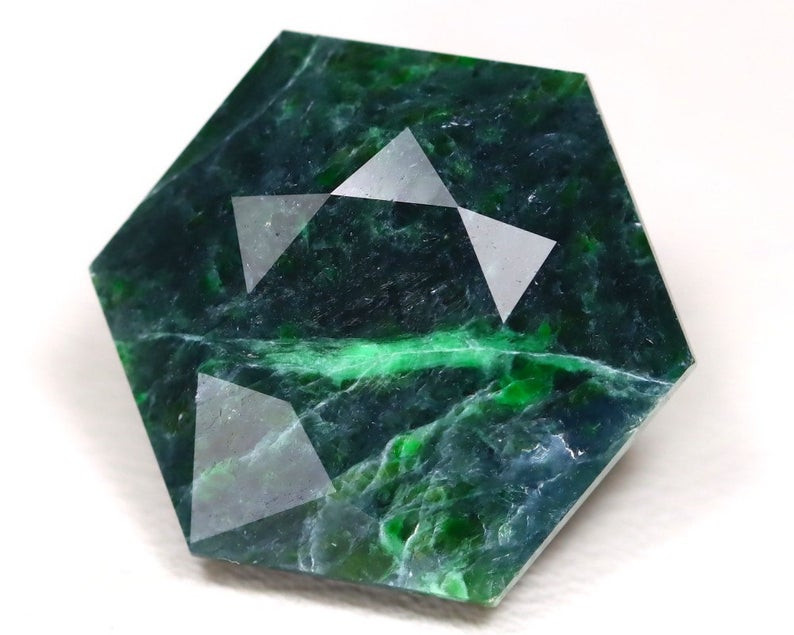
Jade
“Jade” refers to two similar-looking but distinct gems: jadeite and nephrite. Both stones come in multiple green shades. Nephrite shows muted, pale to deep green hues, while jadeite generally has more saturated apple-green to emerald-green hues. The emerald-green color, called “Imperial Green,” is the most valuable.
Another connection between jadeite and emerald resides in Thailand: the Emerald Buddha. No other religious icon is more revered in Thailand, but guess what? It’s made of green jadeite!
Ancient Chinese beliefs held that jade represented nobility and virtue. Nowadays, jade symbolizes wisdom, humility, and prosperity, along with commemorating the 12th wedding anniversary.
Jade stones’ hardness rankings are fairly average, but they boast the highest resistance to breakage, making them perfect green stones for jewelry.
High-quality green jade can be pricey, though. For jade-lovers on a budget, what green stone looks like jade? That would be maw sit sit!

Maw Sit Sit
Maw sit sit is a rare, bright green rock resembling jadeite. It’s made up of albite feldspar, jadeite, and other various minerals, leading to trade names like “jade albite” and “chloromelanite.” For reference, chloromelanite is a dark greenish-black jadeite variety.
These translucent to opaque green gems usually have dark green or black veining. The vibrant green hue comes from a high level of chromium, the same element that creates green jadeites, green garnets, and emeralds.
Maw sit sit is a pretty modern gem, officially discovered in 1963 by Swiss gemologist Edward Gubelin. Gubelin found the stone in Burma by the Himalayas and named it after a nearby village.
On the healing side, maw sit sit crystals are said to energize and invigorate those struggling with depression, helping them discover joy.

Alexandrite
Alexandrite is a rare color-changing gemstone in the chrysoberyl family. The best alexandrite stones transition from emerald-green under sunlight to ruby-red under incandescent light.
Other alexandrites might be teal or blue in sunlight and pink to purple in incandescent light. Most gemologists only classify it as “true” alexandrite if it shows distinct red to green changes.
Alexandrite is particularly beloved in Russia, the nation of its namesake Czar Alexander II. Plus, at the time of its discovery, alexandrite’s green and red hues matched the Russian military colors.
Spiritually, alexandrite symbolizes distinction and aids the circulatory system, according to Chinese beliefs. This red and green gemstone is a June birthstone and 55th wedding anniversary stone.
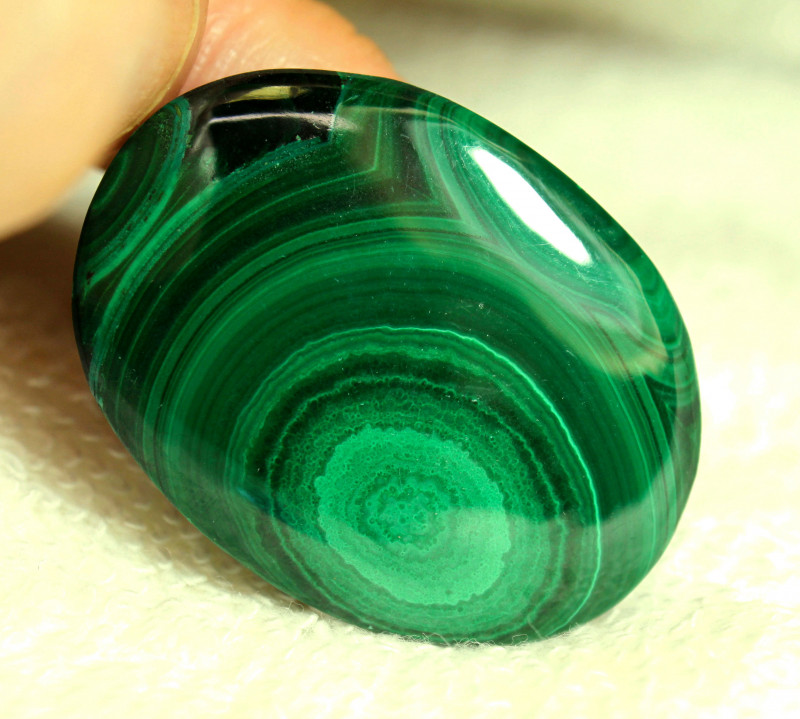
Malachite
Malachite is a vibrant copper carbonate gemstone named after the green mallow leaf. What does malachite look like? Malachite stones have spiraled color-banding in pale to dark green colors.
This opaque green stone is beautiful but unfortunately ranks at a low 3.5-4 on the Mohs mineral hardness scale. Therefore, it’s better for cabochons or less vulnerable jewelry like pendants. Malachite crystals often intertwine with azurite during formation to create azurmalachite, a swirling blue and green jewel.
The Winter Palace in Russia is one example of malachite’s decor potential, holding an entire room decorated with roughly 400,000 pounds of malachite!
Astrologically, malachite is a star stone for Jupiter and Venus, plus a zodiac stone for Capricorn and Scorpio. These green crystals symbolize strength, focus, and mental clarity.
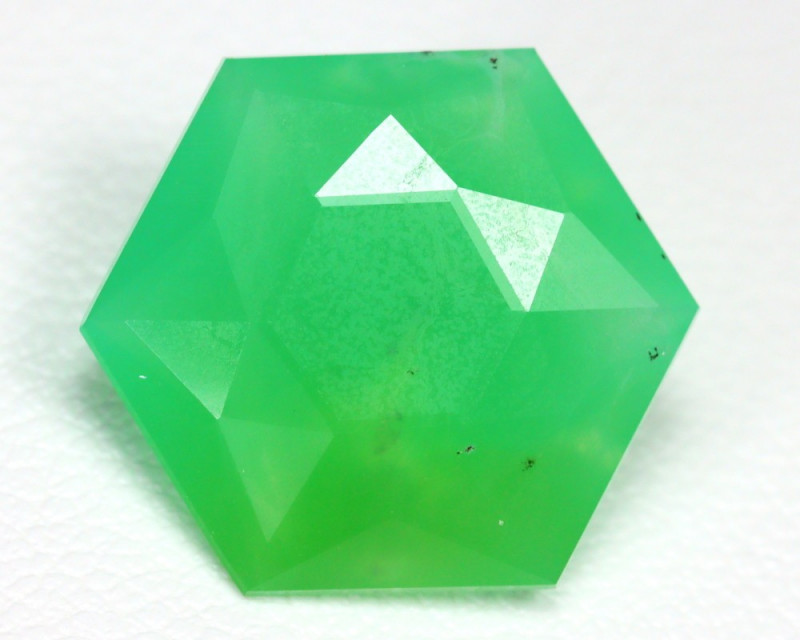
Chrysoprase
Chrysoprase is a chalcedony gem that’s usually seafoam to apple-green but sometimes comes in yellow. Yellow chrysoprase may go by citron chrysoprase or lemon chrysoprase.
Like maw sit sit, chrysoprase resembles jade. Buyers also mistake chrysoprase for chrome chalcedony, but chrysoprase’s green hue comes from nickel while chrome chalcedony’s hue comes from chromium.
The stone’s name comes from the Greek chrysos, for “gold,” and prason, for “leek.” It’s one of many green chalcedony gems but ranks second in value compared to all chalcedony varieties.
Chrysoprase is nicknamed the “Stone of Thought” for its purported ability to strengthen focus and intellect. These green crystals also promote positivity and commemorate the 18th wedding anniversary!
Up next, what is the rarest green gem? That title goes to tsavorite garnet!
Rare Green Gemstones
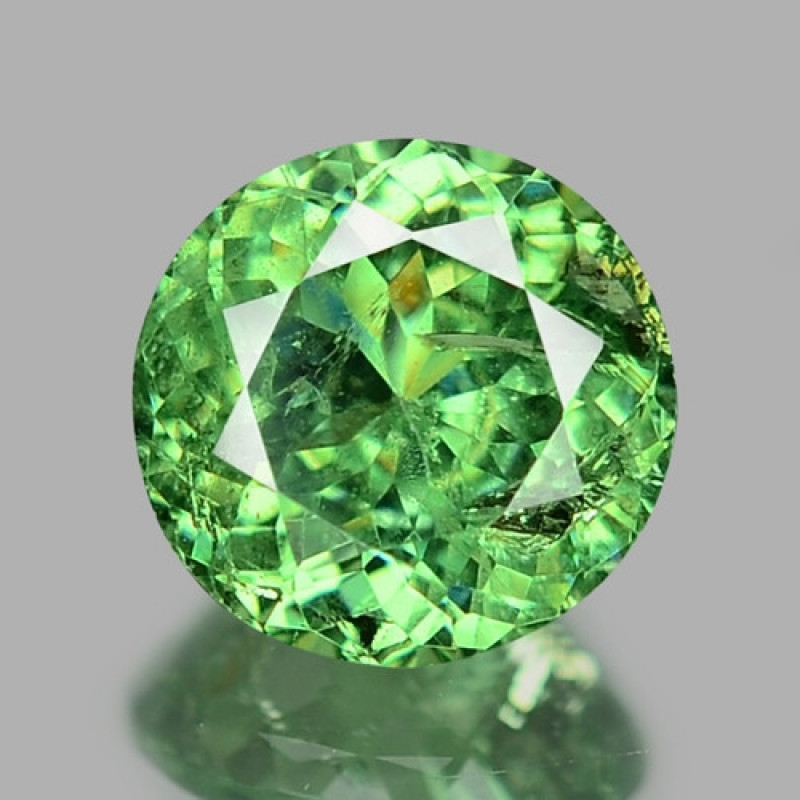
Garnet
The garnet family is complex and varied, boasting two green varieties:
Tsavorite: A grossular garnet variety in vivid yellow-green to blue-green.
Demantoid: An andradite garnet variety in vibrant olive-green to deep emerald-green.
While tsavorite is the rarest green gem, demantoid is the most valuable garnet variety. Demantoid garnets have more dispersion (fire), meaning they sparkle in colorful flashes.
Demantoid’s official discovery occurred in 1852, much longer ago than tsavorite’s discovery in 1967.
Most tsavorite comes from Tanzania, while demantoid is native to Russia. Campbell Bridges, who discovered tsavorite, along with Tiffany & Co. president at the time Henry B. Platt, named tsavorite after the Tsavo National Park in Kenya near the stone’s discovery.
Both green garnets are said to inspire commitment and love. Crystal healers believe these stones can bring wealth and prosperity into your life, perfect for starting the year as the January birthstone!
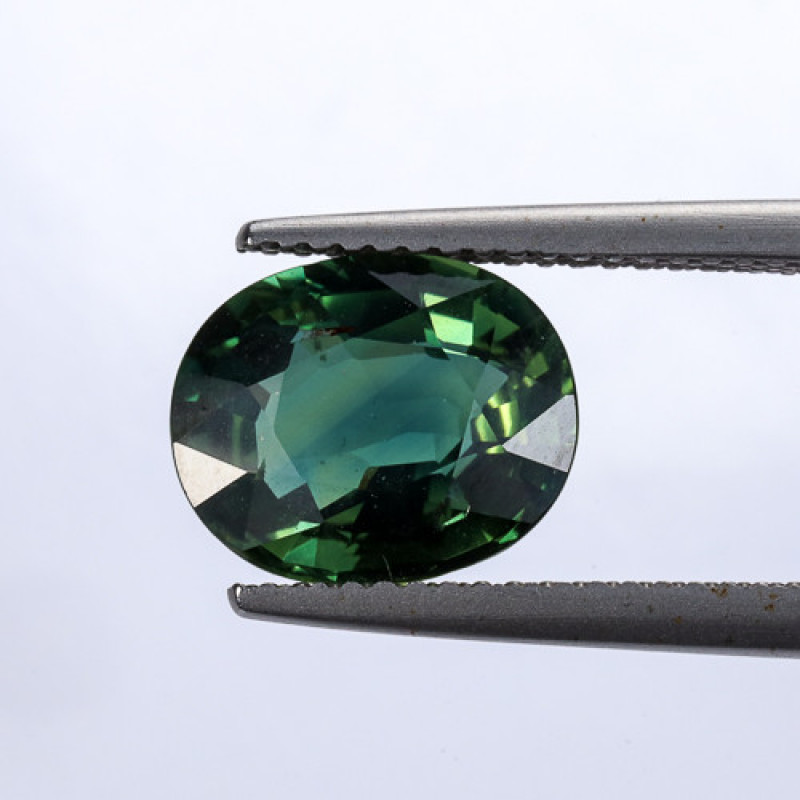
Green Sapphire
While sapphire is traditionally blue, the presence of iron can create green sapphire! Green sapphires range from pale mint-green to forest green, often with blue or yellow undertones. Most often, these stones are olive-green or tan-green.
While green sapphires aren’t widely known, they aren’t very rare. In fact, they’re more affordable than blue or Padparadscha sapphires!
Were you born in September? If so, sapphire is your traditional birthstone! Plus, their high durability (9 on the Mohs scale) makes them some of the best green stones for rings, be it for daily wear or as a unique engagement ring!
Sapphire may come in blue or green, but what stone is blue and green?

Amazonite
Amazonite is an opaque, blue and green stone with mild olive-green fluorescence. This blue-green gem is a tectosilicate mineral. You’ll often see white streaks too, caused by inclusions of albite crystals. However, more albite means lower value.
Polished amazonite stones have spider-web patterns and schiller, a metallic glittering also called aventurescence.
Also called the “Amazon stone,” these stones are named after the Amazon River but aren’t found there. Archeological evidence, specifically jewelry and adornments found in King Tut’s tomb, has proven amazonite was around in ancient Egypt.
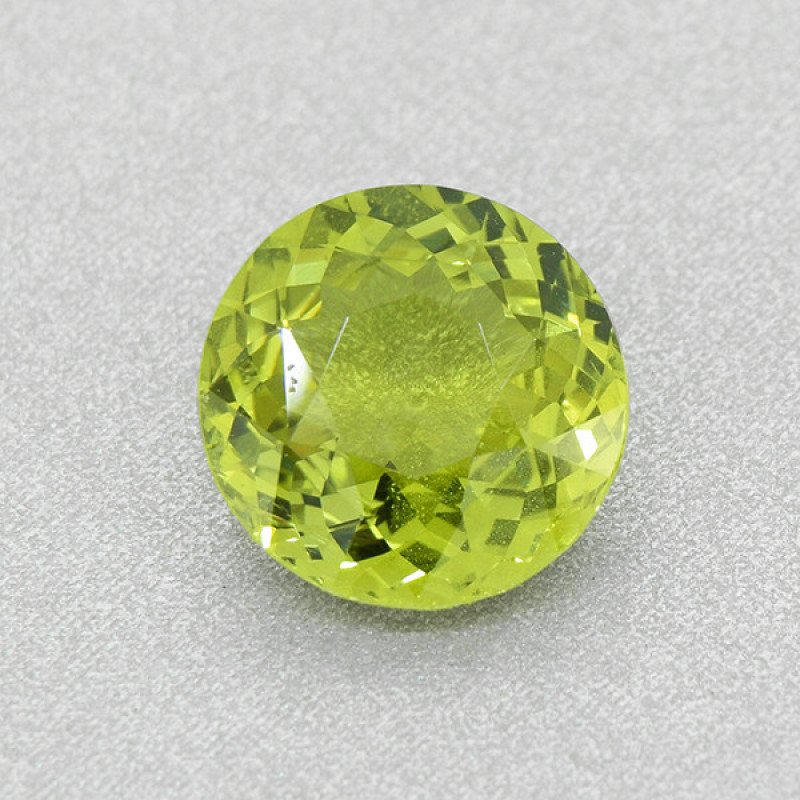
Chrysoberyl
Chrysoberyl is a pale yellow-green to green gemstone known for having the strongest “cat’s eye” effect (chatoyancy) of any gemstone. Not all chrysoberyls show a cat’s eye. The ones that do are best in honey-brown, and the “cat’s eye” reflection might have a glimmer of blue.
Cat’s eye chrysoberyl is called cymophane, translating to “appearing like a wave” for the hazy internal glow. These stones are also pleochroic (showing different colors at different viewing angles) in brown and yellow shades.
The metaphysical uses of chrysoberyl are said to include increasing self-control, improving focus, and balancing the solar plexus chakra. Historically, chrysoberyl stones in Asia were believed to ward off the evil eye.
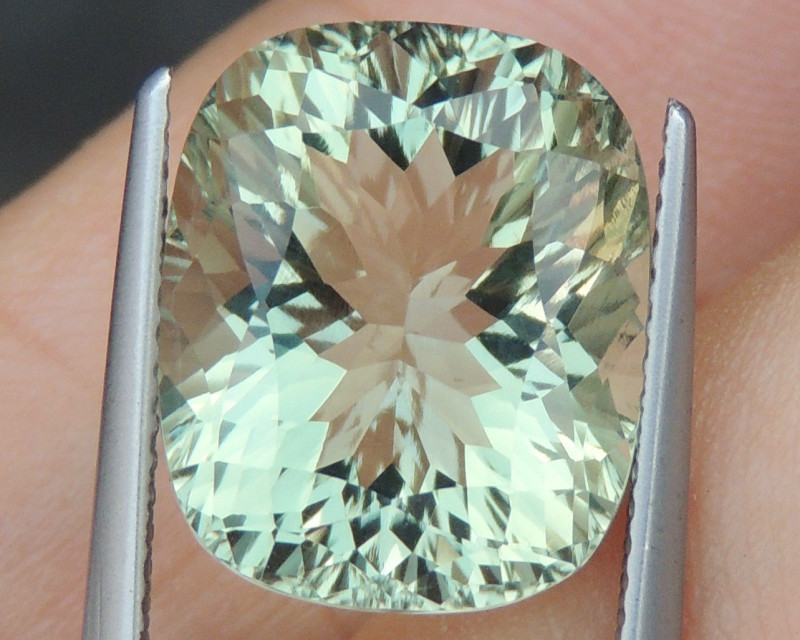
Prasiolite
Quartz comes in many colors, including green! So, what is green quartz? Green quartz is called prasiolite, a translucent pale green stone formed either naturally or by treating amethyst.
Some prasiolite may have purple color zones from remaining amethyst, but most are pale honeydew-green. Other names for prasiolite include vermarine and amegreen.
Prasiolite stones symbolize self-sufficiency and compassion. These light green crystals are called stones for prosperity, said to attract benevolent opportunities and make you believe in yourself.
These gems are also zodiac stones for Capricorn and Virgo. They’re also an affordable alternative to the August birthstone (and the next one on our list): peridot.
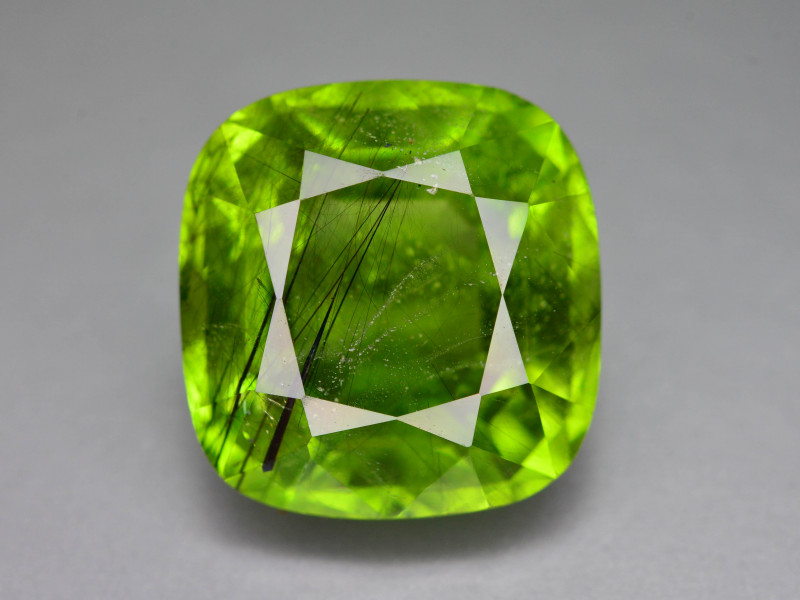
Peridot
When discussing which gemstones are light green, peridot is often top of the list. Peridot, or chrysolite, is an olivine gemstone. These stones are usually light but vibrant shades of olive-green with amber undertones, though some are forest green with yellow undertones.
These light green stones are popular in healing circles for bringing better sleep, emotional balance, and lower stress levels.
One fact you may not know is that peridot is pronounced pair-ih-doh! An even more fascinating fact: some of these stones, called space peridot, come from meteorites! As you know, peridot is also an August birthstone.

Turquoise
Turquoise is an opaque, hydrated copper and aluminum phosphate stone in shades of blue-green or blue. Most often, you’ll see turquoise with white to brown veins or patches, which sometimes creates designs like the lace-patterned “spiderweb turquoise.” The veining is a matrix, caused by remnants of turquoise’s host rock.
Its name comes from the 17th-century French word turquois, for “Turkish,” as Turkish explorers introduced these stones to medieval Europe. Turquoise was known for centuries earlier, though, with names like callais to ancient Greeks or chalchihuitl to Aztecs.
These blue-green crystals are good luck charms, symbolizing tranquility and hope. Their sea-and-sky coloring evokes peace, healing, and protection. Plus, turquoise is a December birthstone and the 11th wedding anniversary gemstone!
Next, we have another blue-green copper carbonate gem: chrysocolla!
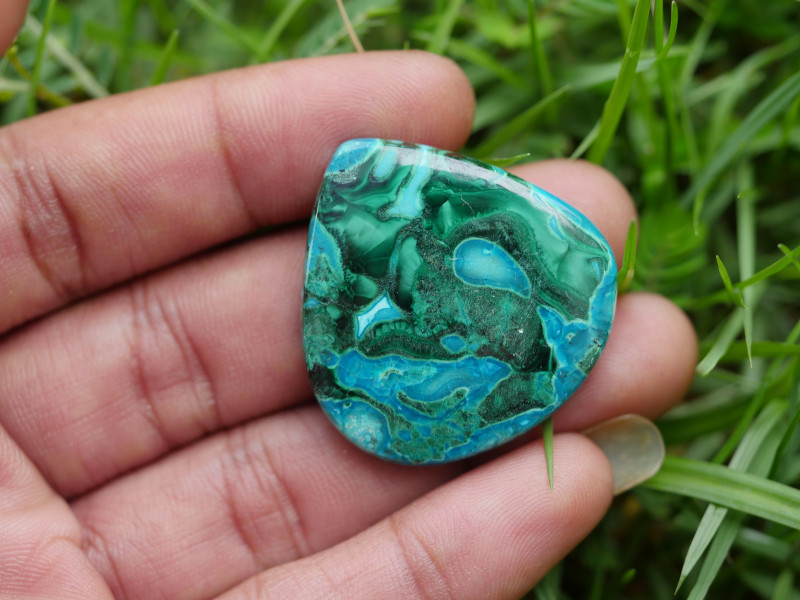
Chrysocolla
Chrysocolla is an opaque copper carbonate stone in teal, blackish-blue, or blue hues, usually with brown veining. Cuprite inclusions can create bi-colored red and teal chrysocolla, while iron oxide inclusions create dimensional gray or black streaks.
Besides inclusions, chrysocolla often mixes with other gems to create distinct varieties. Mixtures of malachite or turquoise, other copper carbonates, are commonly seen giving chrysocolla unique blue and green patterns. The Parrot Wing variety mixes chrysocolla, jasper, azurite, and quartz, creating a greenish-brown stone with red sprinkles.
Since pure chrysocolla ranks at a fragile 2-4 on the Mohs scale, mixing with other gems makes it a more durable option. Chrysocolla rings are perfect as zodiac stones for Geminis!
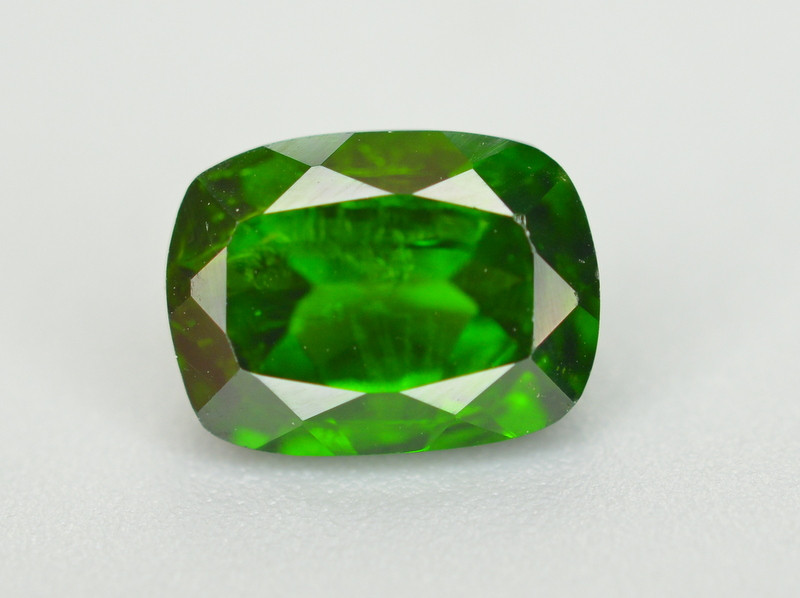
Chrome Diopside
Chrome diopside is a rare, gem-quality diopside stone. The deep, intense coloring of this emerald green gemstone comes from chromium. These stones can fluoresce in violet, green, yellow, and orange. They also have excellent brilliance (sparkle) and clarity.
Besides emerald-green, chrome diopside can also be light green, bright grass green, or dark forest green. Larger specimens typically show darker shades. Most chrome diopside stones come from Eastern Siberia or Pakistan.
Chrome diopside has historically symbolized opportunities for success. The name “diopside” translates to “two” and “vision,” as ancients tied the stone to visualization. Other legends say it came from the religious or mythological tree of life.

Diaspore
Anyone after a color-changing gemstone in soft, floral hues will love diaspore! Diaspore is a transparent, sparkling gemstone that transitions from kiwi green to reddish-pink to champagne under different lighting.
These stones are also dichroic, meaning you’ll see different colors from different angles, including magenta, green, olive, and red. The best color-changing diaspore comes from Turkey, where the stones are called Zultanite or Csarite.
Healing-wise, diaspore may reduce brain fog and improve memory, particularly details of events. These light green gemstones symbolize aspiration, intuition, and acceptance.
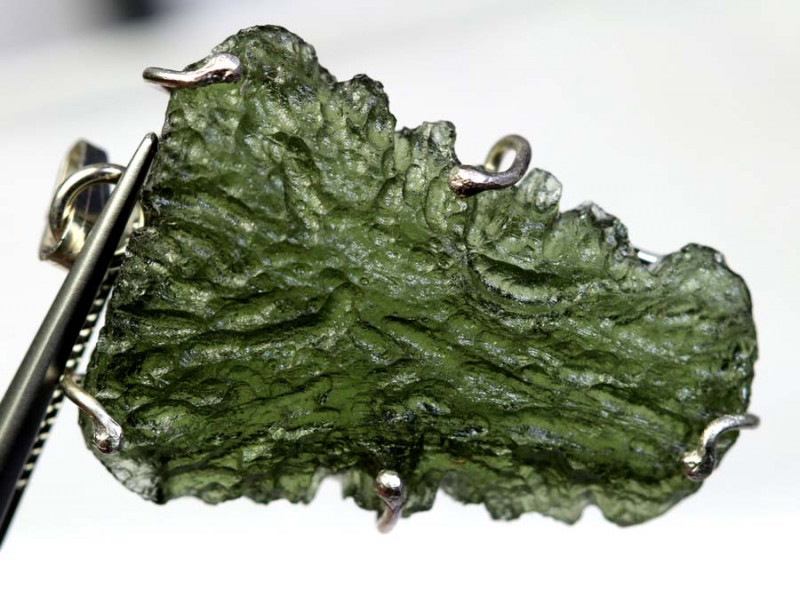
Moldavite
Moldavite is an olive-green silica glass that forms like no other gem — by being shot into space during a meteorite impact, then falling back to Earth. These stones are amorphous (not crystals) and highly valued for crystal healing.
Gem-quality moldavite is often olive-green but can also be dark green, seaglass-green, or turquoise. Regular-grade moldavite has more intense, darker hues with pitting on its surface. High-quality moldavite is more translucent with a fern-like pattern.
Because of its formation, moldavite is often sold as rough specimens. These green crystals, raw, display unique shapes, like the “flower burst” pattern or spirals.
Moldavite is a zodiac stone for Sagittarius. It’s also nicknamed the “Stone of Connectivity” and purportedly facilitates communication and emotional release.
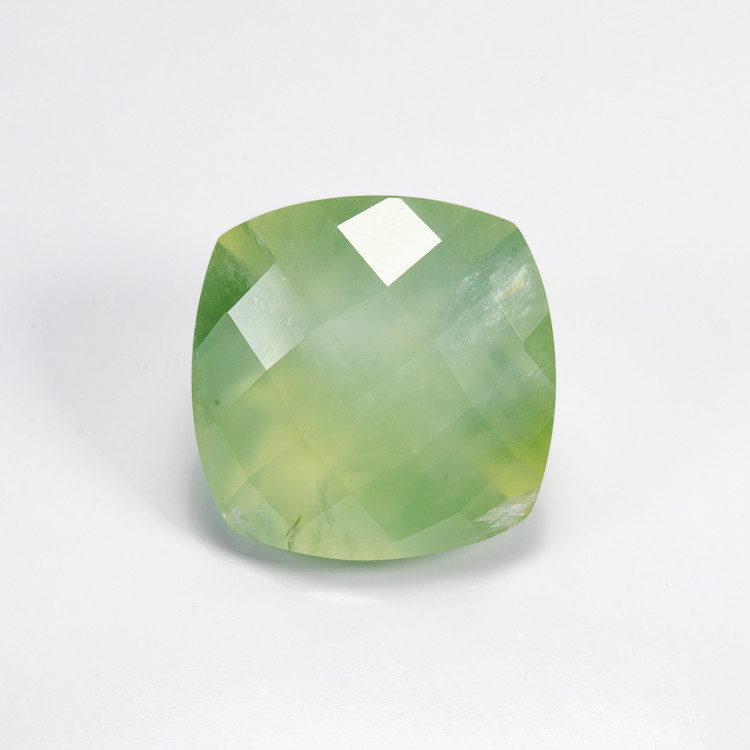
Prehnite
Prehnite is a pear-green silicate gemstone popular with collectors. While not related to jade, some sellers call it “New Jade.” The stone usually has a hazy translucence and often mixes with epidote or black tourmaline. Plus, it glows with a pearly luster (pearlescence) under sunlight!
Prehnite is one of the first gemstones named after someone (Hendrik von Prehn) and the first mineral described from South Africa. Unsurprisingly, this milky green stone has a long history of use in South Africa, where shamans would use it to connect the physical self to the spirit realm.
Additionally, some call prehnite the “Stone of Dreaming” and use it for lucid dreaming or dream interpretation. Prehnite is a lucky zodiac stone for Scorpio, Capricorn, and Libra.
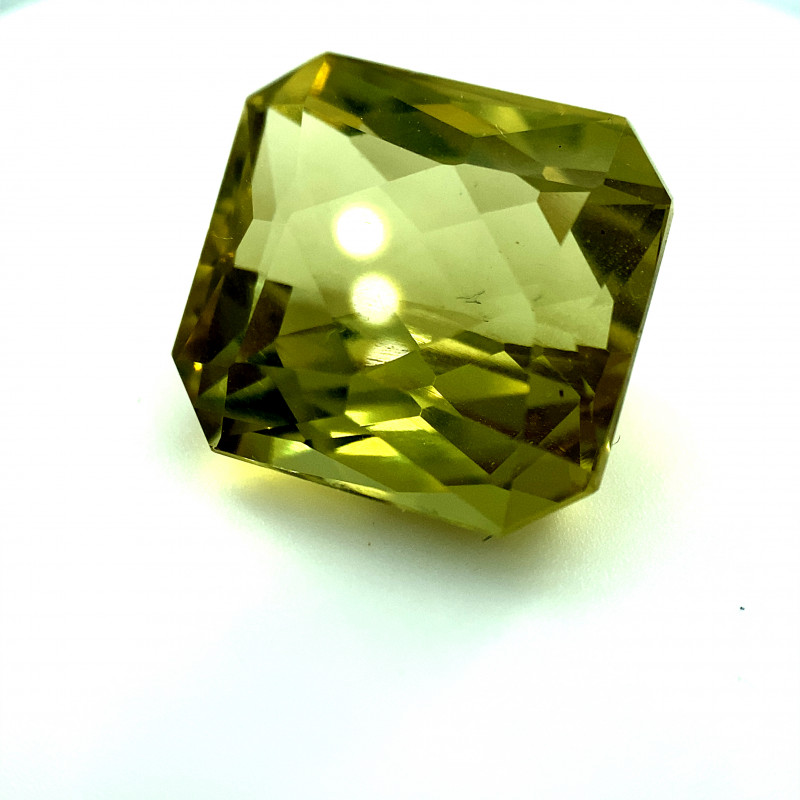
Hiddenite
Hiddenite is a spodumene gemstone in a range of greens including yellow-green, mint, emerald-green, and evergreen. The stone’s rich green shades led to the nickname lithia emerald.
Hiddenite has distinct pleochroism in greenish-yellow, emerald, teal, and colorless hues. Typically, the top of the crystal will be darker and the sides will be lighter.
The stone’s discovery happened by accident when W.E. Hidden, searching for platinum for Thomas Edison, uncovered hiddenite.
As a healing stone, hiddenite may help with stress management and emotional resilience. It’s also a zodiac stone for Libra!
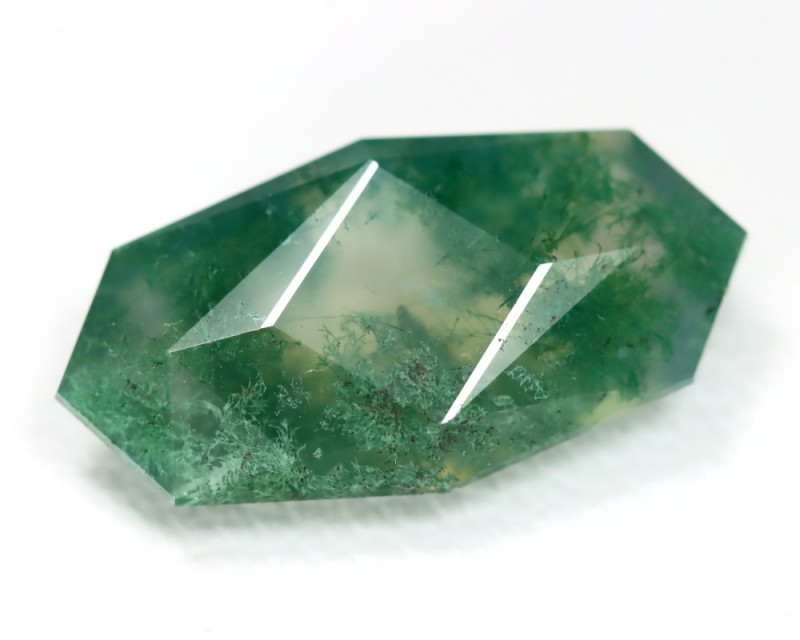
Agate
Agate is a diverse group of translucent, banded chalcedony gems. There are four primary types of green agate:
Green Agate: A pale to deep green variety used for ancient Egyptian jewelry, seals, and ships.
Moss Agate: A predominantly green variety, with milky or transparent colorless sections, known for its fern-green or blue-green mossy inclusion patterns.
Indian Agate: An earth-toned variety dominant in green hues, often combined with beads of other green gemstones from India.
Botswana Agate: A typically pink and gray variety that can be found with green and white banding.
Indian agate has particular spiritual significance. It’s popular for mala beads or prayer beads often worn by religious leaders. In Indian culture, the green banded stone is called the stone of three sages: Rishis, Sadhus, and Fakirs.
All green agate stones symbolize generosity and empathy. Common crystal healing uses for these stones include resolving conflicts and increasing emotional awareness.
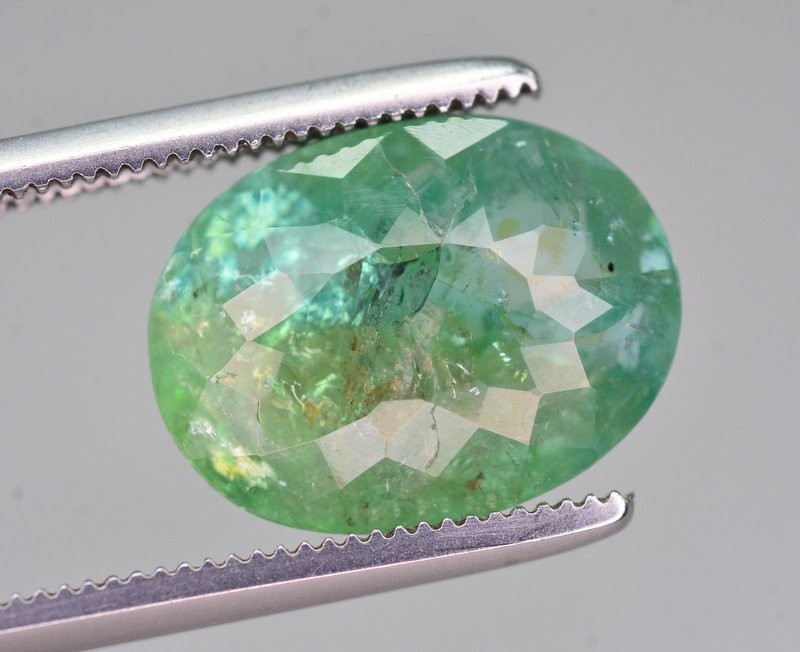
Green Tourmaline
Looking for green stones that look like emeralds? Look no further than green tourmaline! Verdelite tourmaline has the closest resemblance to emerald but is just one of the green tourmalines:
Chrome Tourmaline: A rare, bright green dravite tourmaline from Tanzania.
Paraíba Tourmaline: The rarest and most valuable variety, an intense neon blue, blue-green, or violet elbaite tourmaline from Brazil. Many cool-toned tourmalines are treated to appear closer to Paraíba.
Verdelite: An emerald-green elbaite tourmaline called “Ceylonese peridot” or “Brazilian emerald.”
Watermelon Tourmaline: A bi-colored pink and green elbaite tourmaline variety with a pink center and green edges or stacked color layers.
Green tourmalines have strong pleochroism in dark to yellow-green hues, though the best ones show directional green and blue. Green varieties also have Type I colored gemstone clarity, the best clarity of tourmaline types.
Tourmaline comes in a rainbow of colors, but the first official discovery in 1554 was a green tourmaline. The stone is a traditional October birthstone and 8th wedding anniversary gemstone!
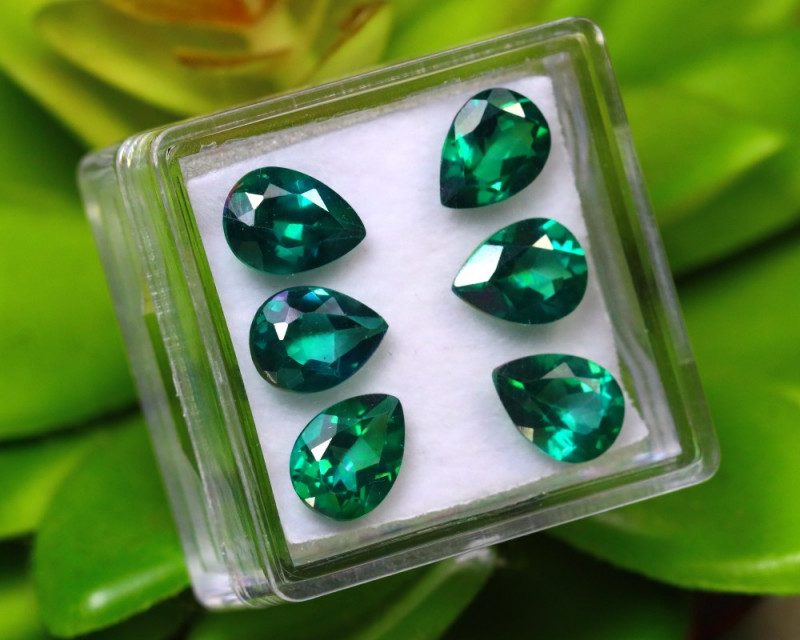
Green Topaz
You may know other topaz colors like blue topaz better, but green topaz is a worthy contender when it comes to green stones for jewelry. With an 8 ranking on the Mohs scale, bright pleochroism, and excellent clarity, these light green stones are perfect for rings or necklaces.
Green topaz displays bright teal, colorless, and green pleochroism. Other topaz colors can glow with yellow-green or greenish-white fluorescence. Most green topaz stones come from the Ural Mountains of Russia or New South Wales.
December babies who prefer green over blue can opt for a green version of their birthstone, along with those celebrating their 4th wedding anniversary! Born in November? Topaz is a November birthstone too!
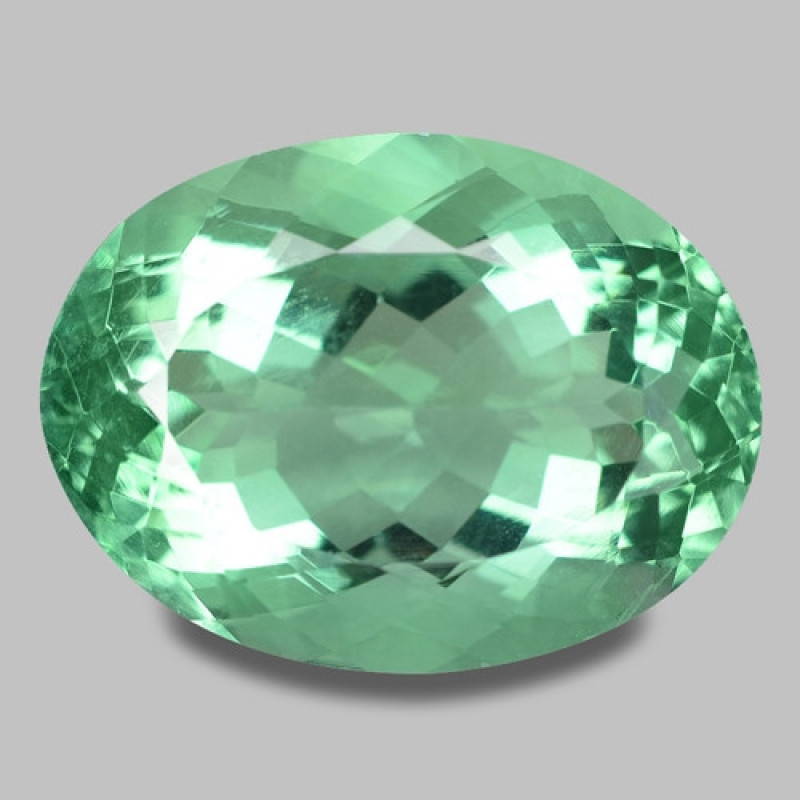
Green Fluorite
Fluorite is a calcium fluoride gemstone with a vast color range. The most common colors are green and purple. Color-zoning or banding is common as well, most often in green, blue, and purple. Additionally, color-changing fluorite stones shift from blue or blue-green to pale green and lavender under incandescence.
As with all fluorite, this green gemstone’s identification comes down to its fluorescence. While some have a yellow glow, most fluorite has a strong blue-violet glow. And, the concept of fluorescence came from the discovery of green fluorite’s distinct glow.
Ancient spiritual beliefs surrounding fluorite claimed it granted wisdom and spiritual awareness to its wearer. Today, these dark green crystals are nicknamed “Stones of Unity” and serve as the state gemstone of Illinois, USA.

Green Jasper
Jasper stones are a group of opaque chalcedony gems with varied multicolor patterns, typically in earth tones.
Let’s look at the light and dark green crystal names in the jasper family:
Green Jasper: A light to dark green variety called “rain bringer” by Native Americans.
Bloodstone/Heliotrope: A dark green variety with yellow or blood-red speckling from hematite.
Fancy Jasper: A similar variety to bloodstone, but with additional colors besides green and red (rose, beige, and brown).
Rainforest Jasper: A lime-green rhyolite variety with yellow, white, and red inclusions. It may have a black and gray matrix, and the lime green crystal’s names also include “Jungle Jasper.”
Green Imperial Jasper: A warm-toned variety in pastel shades of red, pink, brown, and white with a green shine.
Turquoise Jasper: A turquoise-colored variety with black speckles and lines.
Generally, jasper stones are said to bring self-awareness and willpower. Native Americans believe green jasper can bring rain, while crystal healers use fancy jasper or rainforest jasper to promote joy. Additionally, bloodstone is a March birthstone!

Green Opal
Common opals (those without play-of-color) come in many body tones, including green! This October birthstone comes in multiple shades including emerald-green, yellow-green, and most often, muted jade.
The best green opals come from Tanzania and Madagascar. Tanzanian green opals, called prase opals, are translucent and jade-green. Madagascar’s green opals are usually lime-green. Some green opals contain mineral or organic inclusions, even insect or animal fossils!
However, if you see a stone called “green swiss opal,” it’s not opal but rather misnamed chrysolite. Here’s what to look for with this green gemstone’s identification:
A mild, milky luster underneath the surface.
Possibly webbing or speckling, but no horizontal stripes, color-banding, or strange patterns.
The ability to be scratched by any gems above 5.5-6 on the Mohs scale.
The metaphysical nickname for opal is the “Stone of Resolution,” for its alleged ability to help you release worries and heal from trauma. These stones also represent tenderness and love.
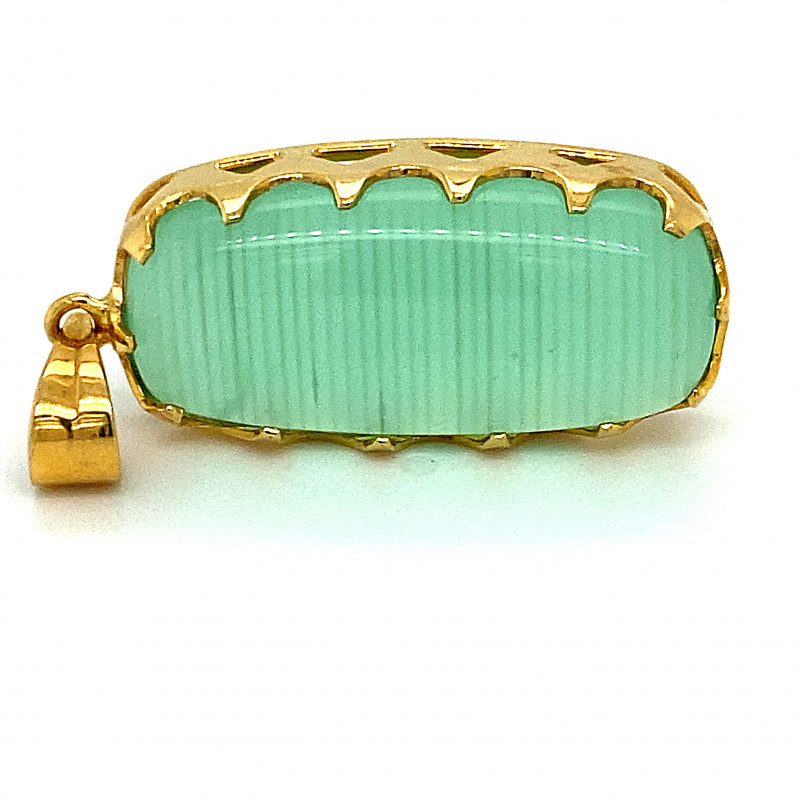
Green Calcite
Green calcite is a variety of the calcium carbonate mineral calcite, known for its range of uses in various industries like construction and agriculture. The primary sources for green calcite are Brazil and Mexico.
Calcite is a soft stone, only ranking 3 on the Mohs scale, so tumbled stones or cabochons are more common than faceted jewelry. However, their luminescence is impressive, glowing yellow with fluorescence, phosphorescence, and thermoluminescence.
These stones grace the zodiac signs Sagittarius and Pisces. Healing-wise, calcite is popular for strengthening your discernment and memory.

Green Moonstone
Moonstone is an orthoclase feldspar gemstone known for its adularescence, a soft, bluish-white internal glow resembling moonlight. While pure moonstones are colorless, iron inclusions can create colors like green! Rainbow moonstone, a green and orange stone, is a beautiful stone but actually a labradorite variety, not moonstone.
Green moonstones can be transparent to translucent. They usually have centipede inclusions — small, thin, intersecting cracks. Moonstones can also show chatoyancy (the “cat’s eye” effect) and asterism, a 4- or 6-rayed star of reflected light.
Moonstone passion and love, along with embracing feminine strengths. Astrologically, this gem graces Cancer signs!
Moving on, what is a sage green crystal called? Green aventurine!
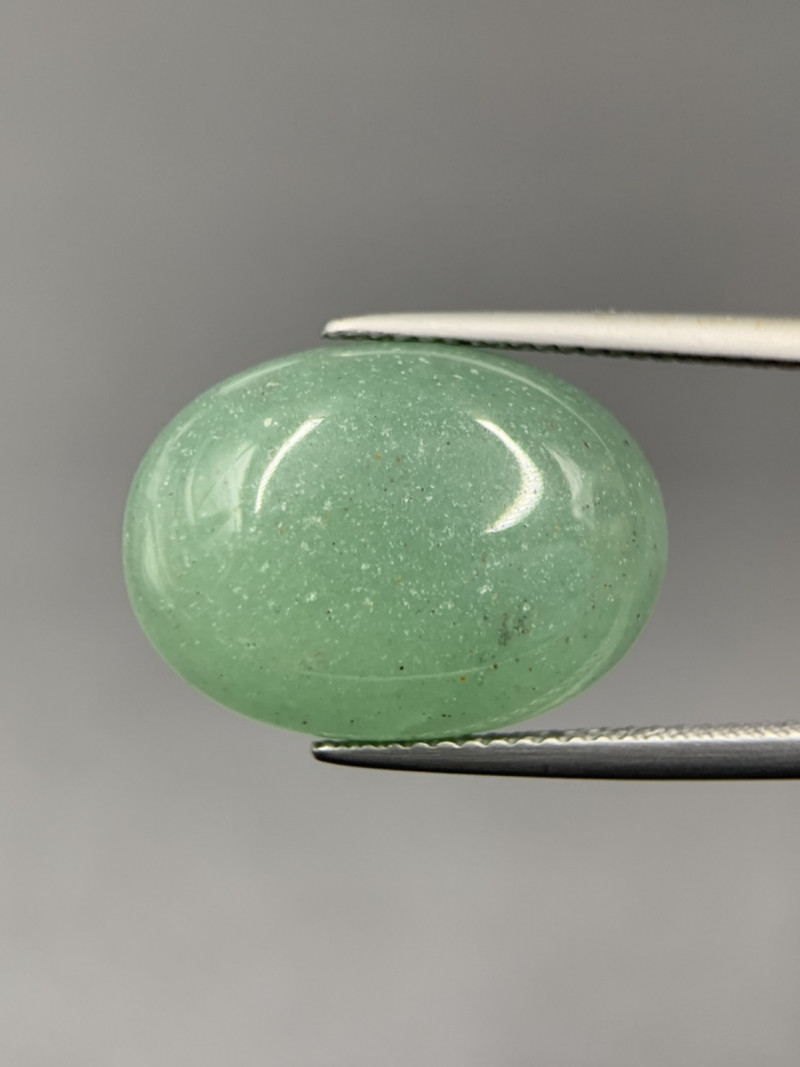
Green Aventurine
Aventurine is a quartz and feldspar gem that comes in many colors. However, green aventurines are the most common and beloved. These crystals are usually sage green but can also be shamrock or forest green.
Certain inclusions can alter aventurine’s color into other green shades. For instance, fuchsite can make the stone icy-green or blue, while goethite can create greenish-brown coloring.
Aventurine is best known for its aventurescence, a metallic glittering effect caused by inclusions of mica or pyrite. Spiritually, green aventurine is said to bring prosperity and self-acceptance.

Green Diamond
Green is one of the rarest diamond colors, especially natural ones. Green diamonds usually have blue, gray, or yellow undertones. The highest-value specimens, graded “Fancy Intense” or “Fancy Vivid” have a saturated, uniform coloring in a medium tone.
These diamonds can be synthetic, treated, or natural. Naturally green diamonds form through natural irradiation, structural defects, or the presence of certain elements like nitrogen or nickel.
Treatments for creating green diamonds include irradiation and coating with a thin silica layer. With both natural and lab-treated green diamonds, the resulting green color is often only a thin surface layer, so faceting these gems is rare.
Two famous green diamonds are the Dresden Green and Aurora Green. The Dresden Green is a 41-carat, faceted diamond with uniform coloring, first recorded in 1772. The Aurora Green is a 5-carat “Fancy Vivid” green diamond set in a ring. This diamond set two records: the most expensive green diamond sold at auction ($16.2 million) and the largest naturally green Fancy Vivid diamond.
Regardless of how they’re made, these April birthstones are a symbol of new beginnings and growth.
Plant Your Roots with Green Gemstones!
You don’t have to be a gardener to have a green thumb — just wear a gorgeous green gemstone ring! Whether you prefer the milky green of prehnite, the earthy hues of jasper, or the classic sophistication of emerald, there’s a perfect green crystal waiting for you!
Don’t be green with envy — find your favorite green gemstone today!
Search the Gemstone Encyclopedia
Related Auctions
Related Articles
Originally the Birthstones or gemstones were associated with a zodiac sign or the month of a individuals birth. Find out what your stone is and view the stones we have for sale
8th Feb 2021
There are so many tools on the market for testing a gemstone, but what are the main tools required for simple analysis. Lets look at four tools for gemstone testing.
4th Mar 2020
Gem Rock Auctions has one of the largest range of Certified Gemstones online. Browse this list of approved gemstone testing laboratories.
24th Jul 2018
Latest Articles
Friedelite is an uncommon pink, red, or brown manganese silicate mineral best known from New Jersey and South Africa. Learn the prices, properties, uses, and history of friedelite gemstones.
23rd Dec 2024
Shortite is a rare mineral and rarer gemstone, usually found as colorless or yellow wedge-shaped crystals. Learn the value, history, and properties of shortite in this guide!
9th Dec 2024
Senarmontite is an uncommon antimony mineral mostly used industrially but occasionally collected as rare gems or pearly crystals. Find out all of the traits, uses, prices, and history of senarmontite.
27th Nov 2024
Article Categories
How To's is where you will find helpful articles from gem Rock Auctions on how to cut gemstones, select gemstones and buy gemstones.
9 Articles








